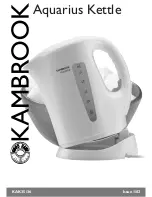
SEPTEMBER 16, 2014
3
F-PEF & F-LEF STATIONARY ELECTRIC KETTLES
TROUBLESHOOTING
SAFETY VALVE MAINTENANCE AND TESTING
CAUTION
Under normal operating conditions a “try lever
test” should be performed every two months.
Under severe service conditions, or if corro-
sion and/or deposits are noticed within the
valve body, testing must be performed more
often. A “try lever test” should also be per-
formed at the end of any non-service period.
CAUTION
Hot, high pressure fluid may be discharged
from body drain and vent during “try lever”
test. Care must be taken to avoid any bodily
contact.
CAUTION
High sound levels may be experienced during
“try lever” test. Wear proper safety equip-
ment and exercise extreme care! Test at, or
near, half of the operating pressure by holding
the test lever fully open for at least two sec-
onds to flush the valve seat free of sediment
and debris. Then release lever and permit the
valve to snap shut.
If lift lever does not activate, or there is no
evidence of discharge, turn off equipment im-
mediately and contact a licensed contractor or
qualified service personnel.
LOW WATER LEVEL
Proper water level must be maintained within the jacket
for the kettle to operate. Depletion of water may occur
from excessive opening of or leakage through the safety
relief valve.
If water is below required operating level, either initially
at start-up or during use, the kettle will automatically shut
off, and the LOW WATER signal light will come on.
In order for the kettle to operate, the following procedure
must be followed:
The kettle must be cool before proceeding with the fol-
lowing steps.
1. Trip the safety relief valve lever to relieve all pressure
from the kettle jacket.
2. At exterior rear of kettle jacket remove nut from Air
Vent.
3. Insert funnel into Air Vent opening and slowly add the
indicated amount of distilled water for:
MODEL
ADD:
COMPLETELY
EMPTY, ADD:
F-20PEF & F-20LEF
220 oz.
(6.5 litres)
548 oz.
(16.20 litres)
F-30PEF & F-30LEF
250 oz.
(7.39 litres)
586 oz.
(17.33 litres)
F-40PEF & F-40LEF
340 oz.
(10.05 litres)
850 oz.
(25.12 litres)
F-60PEF & F-60LEF
420 oz.
(12.42 litres)
1088 oz.
(32.17 litres)
4. Replace Air Vent nut.
5. Follow Air Venting Instructions below.
6. Continue normal Operating Procedure of kettle.
EXTREMELY SLOW COOKING TIME
1. If the cooking time is abnormally slow, then the dif-
ficulty may be due to air being present in the kettle
jacket. To remove air, follow AIR VENTING IN-
STRUCTIONS.
2. If the kettle will not reach and maintain Pressure
Gauge zone in the green area on the gauge when
cold, a slow leak may have developed in the jacket.
Check all fitting connections to jacket including the
heating element gasket. Tighten or replace if neces-
sary.
3. Slow cooking time may also be due to a burnt out
heating element. Test elements and if defective, re-
place complete element assembly.
KETTLE WILL NOT OPERATE WHEN TURNED ON
1. Check that power supply is available to kettle.
2. Kettle will not operate if water level is inadequate in
jacket. Follow LOW WATER LEVEL instructions.
3.
If water level is sufficient and kettle refuses to oper
-
ate, then check that Tilt Interlock Switch in Console
is fully engaged when kettle is in its normally upright
position. Adjust Retaining Tilt Collar if necessary to
assure complete contact with switch and if kettle still
does not operate, then check for defective switch
and/or loose wiring connections.
4. When Thermostat Knob is dialed and TEMPERA-
TURE indicator light does not come on, then it may
be due to either a defective Thermostat or loose wir-
ing connection(s).
5. Check that the Contactor(s) are being energized and
power is being made available to the heating ele-
ments when thermostat is dialed. Replace defective
Contactor(s).
































